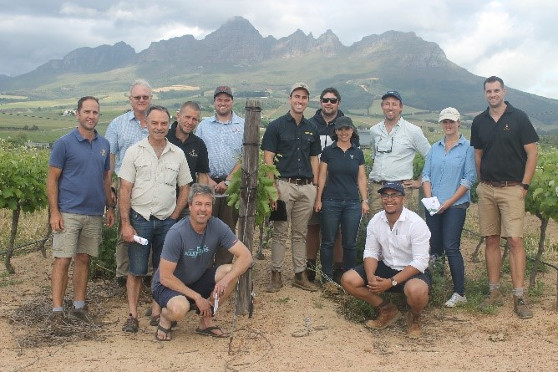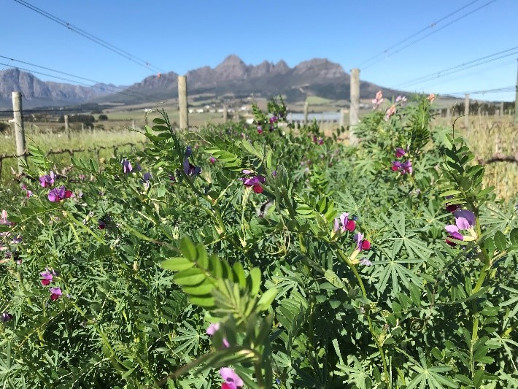Gen Z: Cover Crop Demo’s
Season results and findings
The benefits of establishing a cover crop in the vineyard work row have been well documented and include increased soil organic matter, improved soil structure, enhanced microbial activity, reduced surface crusting, better water infiltration and weed suppression in some cases. While drawbacks such as the cost of seed, increased susceptibility to frost and risk of fires, the likelihood of competition with grapevines and the attraction of pests are valid concerns, these seem to be outweighed by the numerous advantages despite many being unquantifiable in terms of rand value. Ultimately choosing to sow cover crops is a form of playing the long game in the goal towards achieving a more sustainable, diverse and resilient farming system.
The establishment of cover crops, their interaction with soil microorganisms, grapevine roots and insects as well as their response to climatic conditions remains a complex subject, requiring a great deal more scientific research, as well as experimentation by producers. Ascertaining what covers or mixtures are suitable to one’s farming system, soil type and climate, necessitates a bit of trial and error. The need for localised information that is beneficial to a broad range of producers is one of the major reasons for the initiation of the cover crop demos under the Gen-Z Vineyard Project. The cover crop demos are not scientific experiments, but are rather field trials set up to demonstrate to producers what works and what doesn’t under a particular set of conditions. Furthermore the demos serve to inform producers about new species and mixtures on the market.
Producers during the Grower Days at the Cavalli demo sites in 2019
Producers during Grower Days at Cavalli demo sites in 2019.
The information below is a summary of the collective observations made by the GenZ team, Vinpro consultants, producers and technicians from Agricol and Barenbrug:
Region: Coastal
Region: Breede River Valley
Region: Coastal
DISTRICT: STELLENBOSCH
Year: 2019
Demo Site: Kanonkop, Simonsberg
Soil Description: High potential Oakleaf
Sowing Date: Early May 2019
The mixture of white mustard and forage rye produced excellent biomass on this soil type and performed somewhat better than the mixture of forage oats, triticale and forage peas. The rye produced good biomass, while the triticale was average in terms of biomass production. The mixture of oats and stooling rye worked well with the stooling rye producing notable biomass. The phacelia and radish were patchy where these species had been sown by hand, as was the faba bean cover (one of the challenges of small scale field trials). Where these cover crops had been sown in another section of the block using the planter, results were far better with even, dense growth.
Where the phacelia was sewn using the planter, it produced an excellent stand with purple flowers which attracted many bees. The medics which had been sewn by hand on the grapevine row underneath the drippers, was a huge success at this site. Although medics is not aggressive in its growth habit, it did reach just below the cordon wire at various points in the block. This required a team to walk through the block and trample the medics flat on one occasion early in the season. At the time of evaluation, the medics was nearing the end of its life cycle and would be expected to set seed and die off by the end of spring.
| Treatment | Recommended Sowing Rate kg/ha | Performance | Approximate Seed Cost R/ha | Photos taken |
|---|---|---|---|---|
| White mustard + forage rye | 3 + 30 | Very good/Excellent | 675 | |
| Forage oats + triticale + forage peas | 20 + 40 + 15 | Good/Very good | 800 | 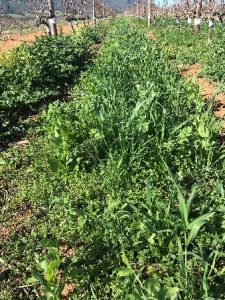 |
| Rye | 45 | Good | 675 | |
| Triticale (2 species) | 100 | Average | 800 | |
| Phacelia | 7 | Average (by hand) Excellent (planter) | 805 | 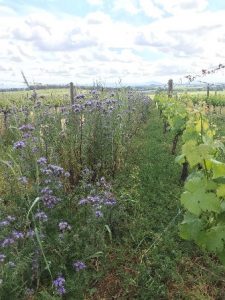 |
| Premix: oats (3 species) and stooling rye | 40 | Very good | 693 | |
| Forage radish and vetch | 2+10 | Good | 600 | |
| Faba beans | 80 | Average (by hand) Very good (planter) | 950 | |
| Medics (on the bankie) | 5 | Excellent | 495 | 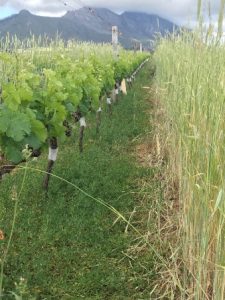 |
District: Stellenbosch
Year: 2019
Demo Site: Cavalli, Helderberg
Soil Description: Granite-based duplex
Sowing Date: Late April 2019
Cover crops at the Helderberg site produced good biomass in general. The forage barley and pea mixture produced reasonably high biomass. The forage rye produced a higher biomass than the forage barley. Forage rye has a longer growing season than forage barley, which should be taken into consideration when selecting a cover crop species to suit planned sewing and termination dates. The forage radish, triticale and vetch mixture yielded good biomass, although the radish produced a small bulb. The bitter lupine and vetch mixture produced high biomass, and provided good weed suppression. The oats, radish and vetch mixture produced a low but dense stand with good biomass and good weed suppression. The triticale stand was average as was its weed suppression. The rye produced a taller stand with better weed suppression. The phacelia, a later-growing species, produced a good stand with medium to high biomass, excellent weed suppression and purple flowers in first two weeks of October.
| Treatment | Recommended Sowing Rate kg/ha | Performance | Approximate Seed Cost R/ha | Photos taken |
|---|---|---|---|---|
| Forage barley + forage peas | 35 + 25 | Good/Very good | 700 | |
| Forage rye | 45 | Very good | 680 | 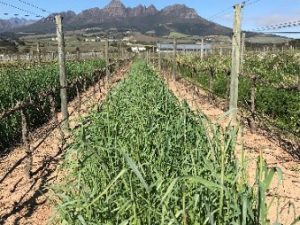 |
| Forage radish + triticale + vetch | 1.5 + 40 + 6 | Good | 680 | |
| Pre-mix: Oats + stooling rye + radish + tiller radish + vetch | 30 | Excellent | 950 | 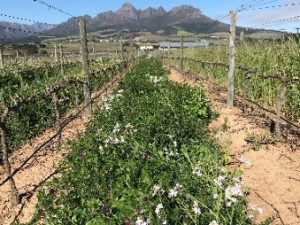 |
| Rye | 45 | Very good | 675 | 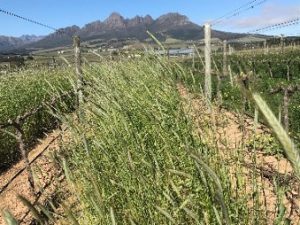 |
| Bitter lupins + vetch | 35 + 8 | Excellent | 532 | |
| Triticale | 100 | Average | 750 | |
| Phacelia | 7 | Good | 805 |
District: Stellenbosch
Site: Cavalli
Soil description: Sandy loam
Vineyard irrigation: Drip
Sowing date: Early May
Sowing method: By hand
The suitability of the mixes to this site was largely favourable with most of the mixes performing well, despite not receiving any fertiliser. The rye with
bitter lupins produced the largest biomass of the eight mixes, but mixes 4, 5 and 7 were not far behind.
| Row | Product mix & species | Recommended sowing rate & seed cost | Comments | Photos taken: Late September 2020 |
|---|---|---|---|---|
| 1 | Hexvallei mix with rye Rye, Oats (Magnifico), Ripper radish (Groundhog), Japanese radish (Nooitgedacht), Common vetch (Timok) | 30 kg/ha R594/ha | Stand height: Medium Stand density: Good Weed suppression: Good | 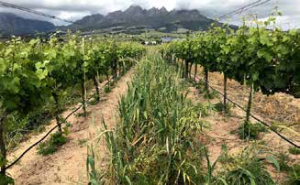 |
| 2 | Rye (Duiker max), Bitter lupins (SSL 10) | 40 kg/ha R600/ha | Stand height: Medium Stand density: Very good Weed suppression: Very good Rye did reasonably well, while the lupins created effective competition for weeds. | 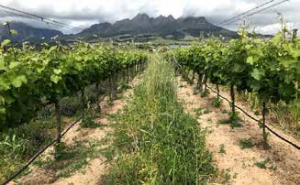 |
| 3 | Agrilife 2 Stooling rye (Macblue), Oats (Magnifico), Ripper radish (Groundhog), Japanese radish (Nooitgedacht), Common vetch (Timok) | 30 kg/ha R950/ha | Stand height: Low to medium Stand density: Very good Weed suppression: Excellent The oats together with the radish and vetch created a dense stand. Stooling rye prefers lighter sandy soils. | 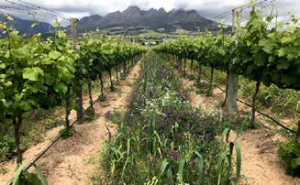 |
| 4 | Mooigezight mix Polymorpha medic (Cavalier), Barrel medic (Paraggio), Subterranean clover (Dalkeith), Balansa clover (Paradana), Bitter lupins (SSL 10) | 30 kg/ha R850/ha | Stand height: Low Stand density: Very good Weed suppression: Very good Dense, low-growing stand or cover. | 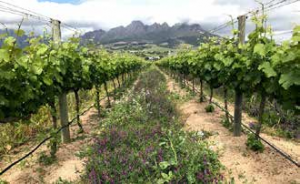 |
| 5 | Goudini mix with triticale Triticale (AG Beacon), Oats (Magnifico), Ripper radish (Groundhog), Japanese radish (Nooitgedacht), White mustard (Braco) | 30 kg/ha R594/ha | Stand height: Medium Stand density: Good Weed suppression: Good to very good Triticale and oats established early and appeared to overshadow the radish and white mustard. | 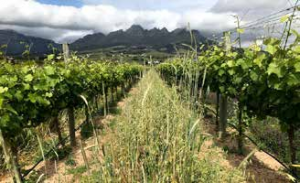 |
| 6 | Goudini mix with barley Barley (SKG 9), Oats (Magnifico), Ripper radish (Groundhog), Japanese radish (Nooitgedacht), White mustard (Braco) | 30 kg/ha R594/ha | Stand height: Medium to high Stand density: Very good Weed suppression: Very good The oats and barley performed quite well compared to the radish and white mustard, possibly an overshadowing effect. | 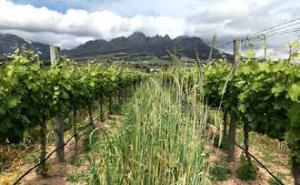 |
| 7 | Vlottenburg mix Triticale (AG Beacon), Oats (Magnifico), Ripper radish (Groundhog), Japanese radish (Nooitgedacht), Common vetch (Timok), Crimson clover (Blaza), Bitter lupins (SSL 10), White mustard (Braco) | 30 kg/ha R650/ha | Stand height: Medium Stand density: Very good Weed suppression: Excellent | 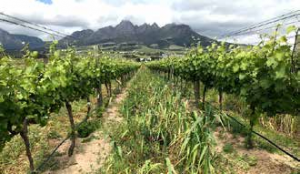 |
| 8 | Swartland medic mix Polymorpha medic (Cavalier), Barrel medic (Parabinga), Button medic (Bindaroo), Subterranean clover (Dalkeith), Balansa clover (Paradana) | 12 kg/ha R1 200/ha | Stand height: Low Stand density: Average to good Suitable for establishment on grapevine row to provide ground cover and suppress weeds. | 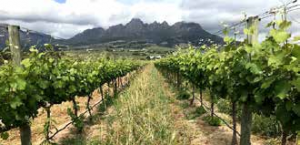 |
DISTRICT: PAARL
District: Paarl
Year: 2019
Demo Site: Olifantskop, Wellington
Soil Description: Weathered granite
Sowing Date: Mid-late April 2019
The mixtures of forage rye with peas and forage rye with bitter lupines were the best performers on this challenging soil type, providing good biomass and weed suppression. The rye, bitter lupines and vetch produced average biomass. The phacelia’s biomass was poor and the mixture comprised of three different oats species with stooling rye, performed reasonably well. The importance of top dressing was illustrated by the clear difference in the density and height of the stands between the ‘top-dressed’ and non-‘top-dressed’ treatments.
| Treatment | Recommended Sowing Rate kg/ha | Performance | Approximate Seed Cost R/ha | Photos taken |
|---|---|---|---|---|
| Forage rye + bitter lupins | 30 + 20 | Excellent | 650 | 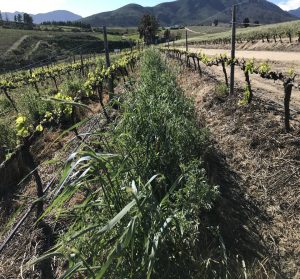 |
| Forage rye + forage peas | 30 + 15 | Very good | 700 | |
| White mustard + oats + vetch | 1.5 + 20 + 6 | Good | 630 | |
| Rye | 45 | Average | 675 | |
| Bitter lupins + vetch | 40 + 8 | Good | 580 | |
| Triticale | 100 | Good | 750 | |
| Premix: oats (3 species) + stooling rye | 40 | Good | 693 | |
| Phacelia | 7 | Average | 805 |
Site: Klipvlei
Soil description: Klapmuts, Cartref, Vilafontes, Genrosa, Oakleaf
Vineyard irrigation: Drip
Sowing date: Late April
Sowing method: Planter
The cereals, such as triticale, oats and barley, did remarkably well at this demo site, treatments 5 and 7 in particular. The inadequate growth of the lupins and peas was likely due to the sowing depth, which was deeper as a result of using a planter. Lupins and peas had previously performed well on this site and would be expected to grow well if sown at a suitable (shallow) depth.
| Row | Product mix & species | Recommended sowing rate & seed cost | Comments | Photos taken: Late September 2020 |
|---|---|---|---|---|
| 1 | Hexvallei mix Triticale (AG Beacon), Oats (Magnifico), Ripper radish (Groundhog), Japanese radish (Nooitgedacht), Common vetch (Timok) | 30 kg/ha R594/ha | Stand height: High Stand density: Very good Weed suppression: Excellent | 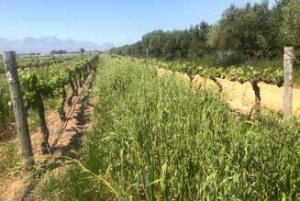 |
| 2 | Triticale (AG Beantly), Bitter lupins (SSL10) | 40 kg/ha R600/ha | Stand height: Very high Stand density: Very good Weed suppression: Very good Cereals performed excellently, while radish and white mustard growth was average. | 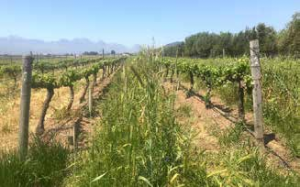 |
| 3 | Treatments 3 in this demo were slashed before images were captured. | |||
| 4 | Treatments 4 in this demo were slashed before images were captured. | |||
| 5 | Goudini mix with triticale Triticale (AG Beacon), Oats (Magnifico), Ripper radish (Groundhog), Japanese radish (Nooitgedacht), White mustard (Braco) | 30 kg/ha R594/ha | Stand height: Very high Stand density: Very good Weed suppression: Very good Cereals performed excellently, while radish and white mustard growth was average. | 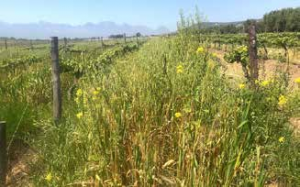 |
| 6 | Goudini mix with barley Barley (SK9), Oats (Magnifico), Ripper radish (Groundhog), Japanese radish (Nooitgedacht), White mustard (Braco) | 30 kg/ha R594/ha | Stand height: High Stand density: Good Weed suppression: Average Radish and white mustard growth was average to poor. | 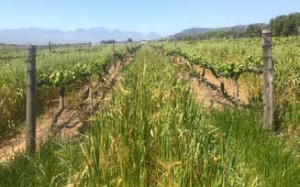 |
| 7 | Oats (Magnifico), Peas (Astronaut) | 40 kg/ha R600/ha | Stand height: High Stand density: Excellent Weed suppression: Excellent Performance of the peas was average, but the oats provided a dense, healthy stand. | 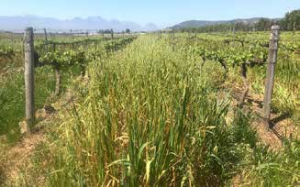 |
| 8 | Swartland medic mix Polymorpha medic (Cavalier), Barrel medic (Parabinga), Button medic (Bindaroo), Subterranean clover (Dalkeith), Balansa clover (Paradana) | 12 kg/ha R1 200/ha | Stand height: Low Stand density: Very good Weed suppression: Good | 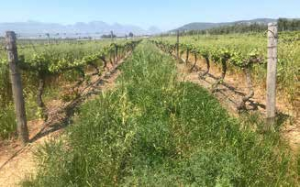 |
DISTRICT: SWARTLAND
Year: 2019
Demo Site: Vlakkenheuwel, Hermon
Soil Description: Well-weathered shale
Sowing Date: Mid-May 2019
All the mixtures performed well at this site. The forage rye in the forage rye and vetch mixture flourished and outperformed all the other cereals and species at this site. The white mustard produced very good stands with and without oats. The mixture of forage barley, forage peas and radish, which offers a good balance of biomass production, nitrogen fixation and bio tillage, produced good biomass and suppressed weeds. The mixture of oats, radish, stooling rye and vetch provided a dense stand with substantial biomass. The mixture of triticale and lupines also performed excellently. The phacelia produced moderate amount of biomass which was comparable to the phacelia growth at other sites in 2019. Although the medics and clover cover was recommended for application on the grapevine row, it grew extremely well in the work row at this site. It is recommended that medics be sown on the grapevine row to provide a good ground cover that is not expected to grow into the grapevine canopy.
| Treatment | Recommended Sowing Rate kg/ha | Performance | Approximate Seed Cost R/ha | Photos taken |
|---|---|---|---|---|
| Forage rye + vetch | 25 + 6 | Excellent | 670 | 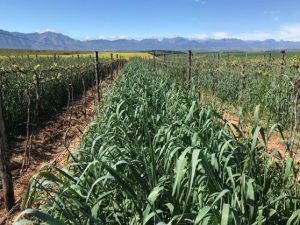 |
| White mustard + Saia oats | 3.5 + 25 | Excellent | 570 | 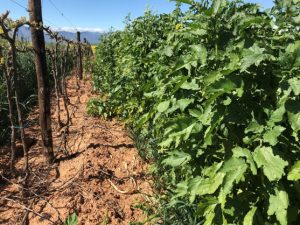 |
| White mustard | 8 | Excellent | 592 | |
| Forage barley + forage pea + radish | 25 + 20 + 1.5 | Very good | 650 | |
| Oats + stooling rye + radish + vetch | 30 | Very good/Excellent | 950 | 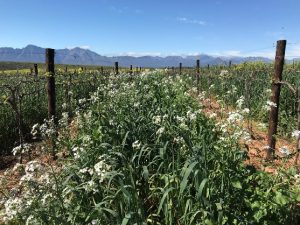 |
| Bitter lupines + triticale | 25 + 60 | Excellent | 655 | |
| Phacelia | 7 | Average | 805 | |
| Medics + clover (on the bankie) | 3 + 2 | Excellent | 470 | 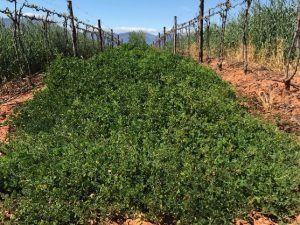 |
Region: Breede River Valley
DISTRICT: BREEDEKLOOF
Year: 2019
Demo Site: Klipdrift (Rawsonville)
Soil description: Sandy
Sowing date: Mid-April 2019
At this demo site, forage rye produced considerable biomass and provided good weed suppression. The standard rye was less impressive in terms of biomass and had begun to dry out in late September, which is perhaps an advantage if water resources are limited and a chemical spray is to be avoided. The black (Saia) oats produced excellent biomass but suppressed the bitter lupines to a degree. An increase in the sowing rate of the bitter lupines sowing rate would overcome this. The forage radish also developed well on this soil and produced good above and below-ground growth.
| Treatment | Recommended Sowing Rate kg/ha | Performance* (Biomass production, even development of the stand and weed suppression) | Approximate Seed Cost R/ha | Photos taken |
|---|---|---|---|---|
| Forage rye | 45 | Excellent | 695 | 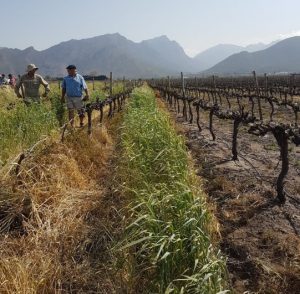 |
| Rye | 55 | Good | 695 | |
| Saia oats + bitter lupines | 25 + 30 | Very good | 590 | 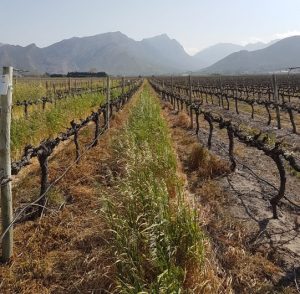 |
| Forage radish + vetch | 2 + 10 | Good/Very good | 600 |
*Performance is an overall indication of the quantity of biomass produced, the development of the stand in terms of even or patchy growth and the degree to which the cover crop suppressed weeds.
Year: 2019
Demo Site: Nuwerus (Rawsonville)
Soil Description: Clay, wet in winter
Sowing Date: Mid-June 2019
The mixture of forage rye and vetch produced average biomass on this soil. The white mustard and forage radish mixture produced a higher biomass compared to the other mixtures.
The forage barley performed better than the forage rye and produced a medium to high biomass. During the winter months, this soil has the tendency to become waterlogged therefore a cover crop with a better tolerance for wet soil conditions such as faba bean would be expected to do well and will be considered for the following . The mixture of medics and clover, which was intended for application on the grapevine row (bankie), performed well despite the somewhat inadequate seeding rate due to its establishment in the work row. The ability of medics, an annual regenerating sward, to re-establish on its own is dependent on various conditions such as water availability, soil chemical and physical conditions and the timing of chemical termination (if required). It is recommended that it be allowed to set seed before termination (if required) and that it be sown for two to three consecutive years on the grapevine row before allowing it to re-establish itself.
| Treatment | Recommended Sowing Rate kg/ha | Performance | Approximate Seed Cost R/ha | Photos taken |
|---|---|---|---|---|
| Forage rye + vetch | 25 + 6 | Average | 650 | |
| White mustard + forage radish | 4 + 2 | Very good | 445 | 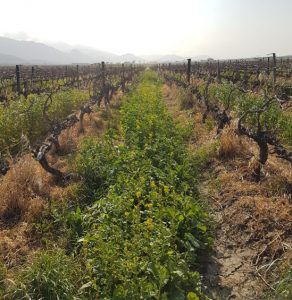 |
| Forage barley | 50 | Good/Very good | 450 | |
| Triticale + vetch | 60 + 6 | Good | 615 | |
| Medics (on the bankie) | 5 | Very good | 495 | 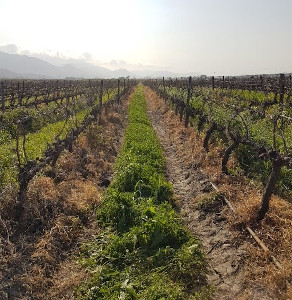 |
DISTRICT: WORCESTER
Year: 2019
The lack of rain in the Robertson and Worcester region in 2019 created challenging growing conditions, and cover crop growth was largely unsuccessful in these regions.
DISTRICT: ROBERTSON
District: Robertson
Year: 2019
The lack of rain in the Robertson and Worcester region in 2019 created challenging growing conditions, and cover crop growth was largely unsuccessful in these regions.
Thank you:



